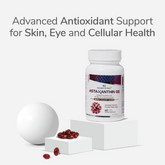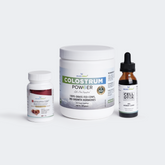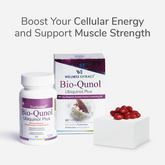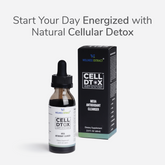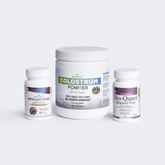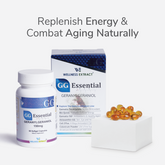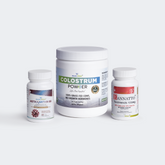Estimated Reading Time: 9 minutes
|Like most people, you’ve probably grabbed a bottle labeled “Vitamin E’’ thinking you’re doing your body a favor. And why wouldn’t you? For decades, vitamin E has been promoted as an essential antioxidant for supporting your heart health, skin, brain, and overall wellness.
But here’s the surprising truth: most vitamin E supplements contain only one form of vitamin E, tocopherols. While tocopherols have been considered the face of vitamin E, they may not be the ones that research suggests deliver the powerful health benefits! In fact, studies now show that tocopherols can at times even interfere with the benefits of their lesser-known cousins.
Yes! The overlooked version, called tocotrienols, may be the superior form of vitamin E, as per the emerging research. They have a stronger antioxidant potential, better cellular penetration, and unique benefits for cardiovascular support, cognitive function, skin health, and even healthy aging. Yet, for years, tocotrienols were overshadowed by the more famous tocopherols.
But why have tocopherols dominated the market for so long?
Here in this article, we’ll compare tocotrienols vs tocopherols to help you understand the science and determine which is the correct form of vitamin E that your body needs.
Vitamin E Isn’t Just One Thing
Here’s what nobody tells you about Vitamin E:
When most people hear ‘Vitamin E,’ they think it’s a single nutrient. Are you too among those? But in reality, it’s a family of eight compounds: four tocopherols and four tocotrienols. (alpha, beta, gamma, and delta).
All together form the vitamin E family or the vitamin E tree. Now let’s explore a bit more about their differences.
Tocotrienols vs Tocopherols – The Head-to-Head Comparison
-
Chemical Structure
In all the vitamin E compounds, the main difference comes down to their chemical structure.
Shorter & More Flexible Tocotrienol: Its molecule has a smaller head and a shorter saturated tail
Bulkier & Less Flexible Tocopherol: Its molecule has a bigger head with a shorter and unsaturated tail.
This structural difference changes how they move in your body.
-
The Absorption Advantage
Tocotrienols have a structural edge. Small and agile tocotrienols move faster in cells, particularly in the vital tissues like the brain, heart, and skin.
Additionally, unsaturated side chains of tocotrienols make them more mobile and flexible, letting them penetrate deeper and absorb better into cell membranes.
-
The Flexibility Benefit for Your Brain
As we age, supporting brain health becomes a top priority. It is the same unique molecular structure that makes tocotrienols more flexible than tocopherols. This flexibility is especially important for hard-to-reach areas like the brain.
The blood-brain barrier is hard to cross. While tocopherols struggle to get through the barrier, tocotrienols have the advantage of directly slipping through more effectively. This way, they provide natural antioxidant support where it truly matters. Research has shown that tocotrienols may:
-
Support memory and cognitive function.
-
Reduce brain cell death after stress events like strokes.
-
Tocotrienols Win for Your Heart Too!
For years, people took vitamin E hoping to protect their hearts. But when large clinical trials were done, the results for tocopherols were mixed or, rather, disappointing.
Why?
Tocopherols don’t strongly affect cholesterol pathways or arterial plaque. On the other hand, studies show that tocotrienols show a much stronger impact in:
-
Cholesterol regulation: They influence the enzyme HMG-CoA reductase (the same enzyme targeted by statins), which helps manage cholesterol production.
-
Plaque reduction: Some studies suggest that tocotrienols may help slow or even reduce arterial plaque buildup.
-
Inflammation control: Tocotrienols reduce inflammatory markers that link to heart disease.
-
Skin & Aging- A Visible Difference
Vitamin E delivers powerful skin benefits and helps reduce signs of aging. While both tocotrienols and tocopherols act as antioxidants, tocotrienols’ stronger mobility gives them an edge in supporting skin health.
-
Tocopherols: Provide surface-level antioxidant support.
-
Tocotrienols: Penetrate deeper into cell membranes, protecting skin from oxidative stress, supporting collagen, and helping maintain elasticity.
Tocopherols vs. Tocotrienols: A Table of Differences
|
FEATURE |
TOCOPHEROLS (Common Vitamin E) |
TOCOTRIENOLS (Rare Vitamin E) |
|
Chemical Structure |
Straight, big tail, less flexible |
Short, curved tail, enters cells more easily |
|
Absorption |
Slower, not as efficient |
Faster, better absorbed by the body |
|
Antioxidant Power |
Good but limited |
Up to 40-60X stronger in fighting free radicals |
|
Cholesterol & Heart |
Mixed or no clear results |
Helps lower cholesterol, supports arteries |
|
Brain Health |
Little evidence |
Protects brain cells, studies for memory and stroke recovery |
|
Skin & Beauty |
Basic antioxidant effects |
Natural antioxidant protection, supports healthy skin |
Why do Most Supplements Give You Tocopherols Only?
You may now ask if tocotrienols outperform tocopherols in so many ways, then why no one knows about them and why tocopherols are so famous.
Researchers discovered alpha-tocopherols first back in the 20th century. The supplement industry focused on this vitamin E form as it was:
-
Easy to isolate
-
Cheap to produce
-
Easier to study
-
Stable for supplements manufacturing
Hence, over time, Vitamin E became almost synonymous with alpha-tocopherol, even though it’s just one of the eight forms. This form became the default vitamin E in multivitamins and standalone capsules.
The marketing shortcut left tocotrienols in the shadows. But things are finally starting to change with more people becoming aware of the different vitamin E forms and the powerful benefits of tocotrienols.
Newer research shows that tocotrienols may offer unique advantages that tocopherols simply don’t provide. You can call tocopherols steady workers and tocotrienols agile ninjas, faster, more adaptable, and able to reach parts of the body where tocopherols struggle to protect.
Shifting to Tocotrienols? Wait! You Don’t Know This YET
-
Mixing Forms? Tocopherols Can Hold You Back
Not only are the tocopherols less effective, but their higher doses can also actually block tocotrienols from working!
This means that many people taking traditional vitamin E might actually be preventing themselves from getting the full spectrum of benefits. So, if you’re considering shifting to the better version of vitamin E, then you should try combining tocotrienols and tocopherols.
-
Diet Alone Isn’t Enough
The average American diet doesn’t provide you enough tocotrienols. Most of us eat plenty of foods with tocopherols, like nuts and seeds, but foods rich in tocotrienols are rare. Some of the best natural sources of tocotrienols include:
-
Palm oil
-
Rice bran
-
Annatto seeds
But let’s be honest, these aren’t staples in most U.S. kitchens. How often do you cook with rice bran oil or sprinkle annatto powder on your meals? So, unless you’re eating these foods regularly and in abundance, you’re not getting enough tocotrienols from diet alone.
That’s why supplementation is often the only practical way to include tocotrienols for most people. But know that it’s not about replacing whole foods but filling in gaps that modern diets simply don’t cover.
Smart Tocotrienols Supplementation (Avoiding the Tocopherol Trap)
If you’re considering supplementation, here’s what you need to know:
- Choose tocotrienol-rich formulas: Look for labels that specify “tocotrienols.” Annatto-derived tocotrienols are considered safe and purest.
-
Avoid high-dose alpha-tocopherol: It can crowd out tocotrienols and reduce their effectiveness.
-
Take with fat: Vitamin E tocotrienols are fat-soluble. Pairing them with a meal that includes healthy fats (avocado or olive oil) helps with better absorption.
-
Mind the dosage: The advisable ideal dosage for tocotrienols is 100-300 mg. Underlying medical concerns may need higher doses.
NOTE: Consult a medical healthcare professional before starting any supplementation, especially if you’re on blood-thinners, statins, or other medications.
Key Takeaways for You!
- If you’ve been taking tocopherols only: You may not be getting the right vitamin E support you were expecting.
-
If you turn to tocotrienols: You open the door to benefits for your heart, brain, skin, and overall heath that decades of tocopherol-only studies overlooked.
-
If you combine the two: Be cautious; too much tocopherol can inhibit the absorption of the better vitamin E tocotrienols.
Also Read: Are Tocotrienols Supplements Safe For You?
Conclusion: Tocotrienols vs Tocopherols – Choosing the Vitamin E That Truly Delivers
For decades, vitamin E has almost been synonymous with tocopherols. But science is clear now. When it comes to protecting your heart, brain, skin, and overall health, tocotrienols consistently win the race.
The unique molecular structure of tocotrienols makes them powerful antioxidants and more mobile, reaching the tissues that matter most.
On the contrary, tocopherols not only fall short but may also block tocotrienols from doing their job perfectly. That means, if your vitamin E bottle lists ‘alpha-tocopherols’ or ‘vitamin E,’ chances are you are missing out on the real benefits of this essential nutrient. So, if you want vitamin E power, tocotrienols deserve the spotlight and not tocopherols.
Frequently Asked Questions
Q1. Which is better, tocopherols or tocotrienols?
Tocotrienols are often considered as better due to their molecular structure, which provides enhanced antioxidant capacity, better cellular absorption and greater health benefits.
Q2. Can you take tocotrienols and tocopherols together?
Higher doses of tocopherols may interfere with the absorption and bioavailability of tocotrienols. It’s best to avoid taking them together and instead maintain a gap between the two.
Q3. Are tocotrienols good for liver?
Yes. Research shows that strong antioxidant and anti-inflammatory properties of tocotrienols help protect liver cells from damage. Clinical studies suggest that tocotrienols, especially delta- and gamma-tocotrienols, may reduce fat buildup in the liver, improve liver enzyme levels (such as ALT and AST), and support healthy cholesterol and lipid metabolism.
Q4. What foods are high in tocotrienols?
Tocotrienols are naturally found in only a few foods compared to tocopherols. The richest sources include red palm oil, rice bran oil, and annatto seeds (which contain almost pure delta- and gamma-tocotrienols).
Smaller amounts are also present in barley, oats, rye, and wheat germ. Among these, annatto and palm oil are considered the most concentrated natural sources.
Q5. How safe is tocopherol?
Yes. Tocopherols (vitamin E) are generally safe when consumed in recommended amounts. However, very high supplemental doses (above 400 IU/day) may increase the risk of bleeding and interact with blood-thinning medications.
Disclaimer: This blog is for informational purposes only and is not intended as medical advice. Wellness Extract's products are not intended to diagnose, treat, cure, or prevent any disease. Please consult with a healthcare professional before starting any new dietary supplement, especially if you have underlying health conditions or are taking medication.
References:
- Parker, R. A., et al. "Tocotrienols regulate cholesterol production in mammalian cells by post-transcriptional suppression of 3-hydroxy-3-methylglutaryl-coenzyme A reductase." Journal of Biological Chemistry 268.15 (1993): 11230-11238. https://pubmed.ncbi.nlm.nih.gov/8388388/
-
Ramasamy, T., et al. "Delta-Tocotrienol Supplementation Improves Biochemical Markers of Hepatocellular Injury and Steatosis in Patients with Nonalcoholic Fatty Liver Disease: A Randomized Placebo-Controlled Trial." Nutrition & Metabolism, vol. 11, 2014, https://link.springer.com/content/pdf/10.1186/1743-7075-11-52.pdf.
-
Tocotrienol Research. Delta Tocotrienol Supplementation and Liver Support. https://tocotrienolresearch.org/delta-tocotrienol-supplementation-improves-biochemical-markers-of-hepatocellular-injury
-
Tocotrienol.org. Brain Health & Neuroprotection." Tocotrienol Research, tocotrienol.org/en/brain-health-neuroprotection/
-
Szewczyk, K., et al. (2021). Tocopherols and tocotrienols—bioactive dietary compounds; what is certain, what is doubt? International Journal of Molecular Sciences, 22(12), 6222. https://www.ncbi.nlm.nih.gov/pmc/articles/PMC8227182/
-
Wong, Weng-Yew, et al. (2017). Anti-inflammatory γ-and δ-tocotrienols improve cardiovascular, liver and metabolic function in diet-induced obese rats. European Journal of Nutrition, 56(1), 133–150. https://pubmed.ncbi.nlm.nih.gov/26446095/
-
Qureshi, A. A., et al. (2015). Pharmacokinetics and bioavailability of annatto δ-tocotrienol in healthy fed subjects. Journal of Clinical & Experimental Cardiology, 6(10). https://www.sciconx.org/articles/pharmacokinetics-and-bioavailability-of-annatto-tocotrienol-in-healthy-fed-subjects.pdf
-
Zaffarin, Anis Syauqina, et al. (2020). Pharmacology and pharmacokinetics of vitamin E: Nanoformulations to enhance bioavailability. International Journal of Nanomedicine, 15, 9961–9974. https://www.tandfonline.com/doi/full/10.2147/IJN.S276355
-
Wikipedia. Tocopherol. Wikipedia: The Free Encyclopedia, 22 July 2025. https://en.wikipedia.org/wiki/Tocopherol
-
Kresser, Chris. (2024). Tocotrienols: A More Potent (and Safe) Form of Vitamin E. https://chriskresser.com/tocotrienols-a-more-potent-and-safe-form-of-vitamin-e/
-
Delta Tocotrienol Supplementation Improves Biochemical Markers of Hepatocellular Injury and Steatosis in Patients with Nonalcoholic Fatty Liver Disease: A Randomized Placebo-Controlled Trial." Tocotrienol Research, tocotrienolresearch.org/delta-tocotrienol-supplementation-improves-biochemical-markers-of-hepatocellular-injury-and-steatosis-in-patients-with-nonalcoholic-fatty-liver-disease-a-randomized-placebo-controlled-trial/



















